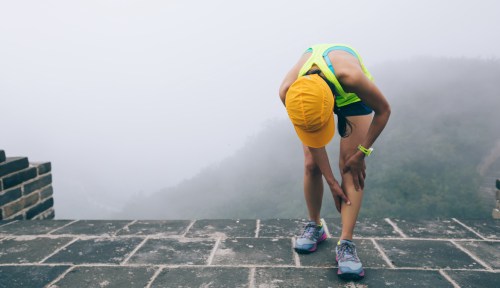Our editors independently select these products. Making a purchase through our links may earn Well+Good a commission
How To Stop Shin Splints in Their Tracks, According to a Physical Therapist
How to stop shin splints in their tracks? Take these five steps at the first sign of any pain along your shins.

This warmer spring weather may be giving you a little more energy to add a sprint or two into that daily run, walk that extra mile, or just get outside and move your body more. Yes! We are here for it!
Experts in This Article
Rebekah Donley, DPT, is a physical therapist at Victor Physical Therapy in Teton Valley, Idaho.
One possible downside to the extra energy and time spent outside? A quick uptick in activity might be causing a bit of soreness or pain in the front of your lower legs: The dreaded shin splints.
“Shin splints are caused by tight calves, repetitive overuse of the tibialis anterior, and fighting the tightness of the calves,” says Rebekah Donley, DPT, of Victor Physical Therapy in Teton Valley, Idaho. According to Penn Medicine, the achy pain you’re feeling is the result of inflammation and small tears in the muscles, bone tissues, and tendons surrounding the shin.
Dr. Donley is no stranger to injuries and ailments from overuse. Her physical therapy clinic is located in a mountain town where skiing, hiking, and mountain biking are never in short supply. Whenever patients ask her how to stop shin splints, she tells them prevention is key—by the time shin splints are sticking around frequently after activities, you’ll need to check in with your physical therapist for an individualized treatment plan.
“As a physical therapist, I would need to know if it’s a unilateral shin splint,”—meaning, on just one shin—”which could be related to a pelvic obliquity, contralateral muscle weakness, etc,” she says. If the shin splints are affecting both of your legs, it probably means you started a new activity too quickly without proper training. Overuse scenarios Dr. Donley sees often are things like diving straight into running after the winter ends, going from being too sedentary at the office then opting for a strenuous workout, and returning to heavy activity postpartum.
But how can you stop shin splints? Before they become a chronic pain you have to fight against day after day, you can get ahead of the problem right away as you’re ramping up your activity.
How to stop shin splints in their tracks
1. Start slow
We get it—the sunshine is amazing. But work up to that 10-mile run or longer power walk gradually. Add just a little distance or time every week and ease into your goals. Most run coaches will tell you to increase your mileage by no more than 10 percent each week.
As soon as you start feeling any niggles, pull back on the amount of time on your feet. Take a day or two off until everything feels back to normal, according to the Mayo Clinic. No need to opt out of all physical activity—just keep things at a low to moderate level. If you don’t pull back, the pain could eventually become a stress fracture.
2. Opt for shoes with arch support
Arch support is key for staving off shin splint pain, says Dr. Donley. Supportive footwear will keep your feet and legs in proper alignment so that your lower leg muscles aren’t getting overworked. (Try the Hoka Gaviota 3 for optimal stability and arch support.)
3. Strengthen your calves
Regularly performing calf raises will help protect your shins. As Erin De Groot, an Orangetheory coach, previously told Well+Good, this simple exercise strengthens the two main muscles of the calf: the gastrocnemius and the soleus, which research shows help to stabilize the tibia, leading to less tension and pain when hitting the pavement.
To do calf raises, stand with the toes of both feet on a slightly elevated surface (like the bottom step of a staircase). Push your heels up and stand on the balls of your feet. Aim for 12 to 20 reps for two or three sets.
4. Stretch, stretch, stretch!
Keep your gastrocnemius from becoming overly tight with this classic wall stretch: Place your palms against a wall, and step one leg backward so your feet are staggered and your toes are pointing forward. With your back leg straight, bend your forward knee until you can feel a stretch in the back leg’s calf. Hold for 30 seconds and repeat with the opposite leg.
Then, try this 17-minute Pilates Power Workout for Runners with Laurence Agenor from Well+Good’s Trainer of the Month Club. The ankle dorsiflexion mobilizations target ankle movement and give the shins a solid stretch.
5. Give your shins some TLC
Most of us are guilty of hitting it too hard from time to time. If you feel the sudden pain in your shin bone, start R.I.C.E., or rest, ice, compression, elevation.
Ice your shins for 15 or 20 minutes, four to eight times a day. Of course, don’t put ice directly on your skin—wrap your shins in a thin cloth or towel first, and place a bag of ice or ice pack on top. Bonus points if you elevate your shins above your heart while you are icing by lying down and raising them on pillows or the arm of a couch. If you have swelling, try a compression sleeve or socks to help with circulation like CEP Cap Sleeves.
Oh hi! You look like someone who loves free workouts, discounts for cutting-edge wellness brands, and exclusive Well+Good content. Sign up for Well+, our online community of wellness insiders, and unlock your rewards instantly.
Sign Up for Our Daily Newsletter
Get all the latest in wellness, trends, food, fitness, beauty, and more delivered right to your inbox.
Got it, you've been added to our email list.










